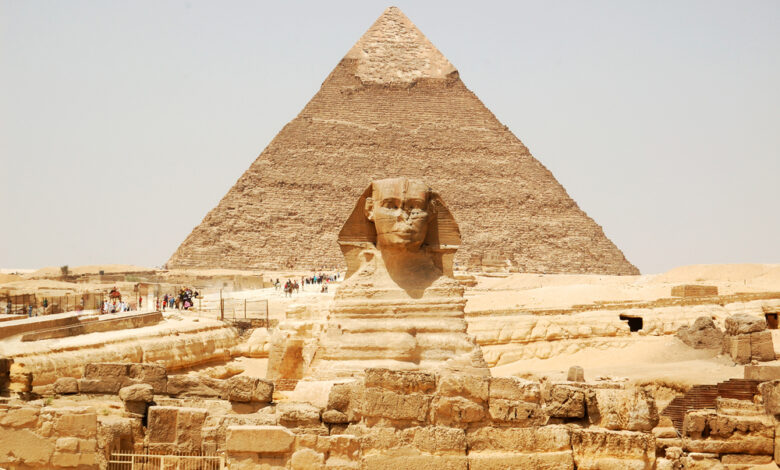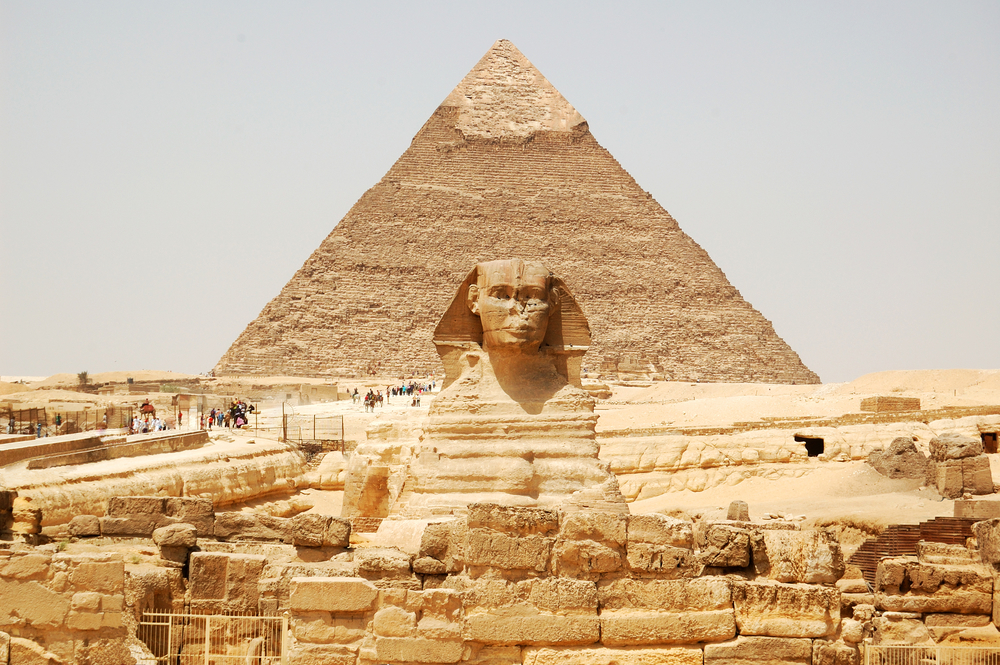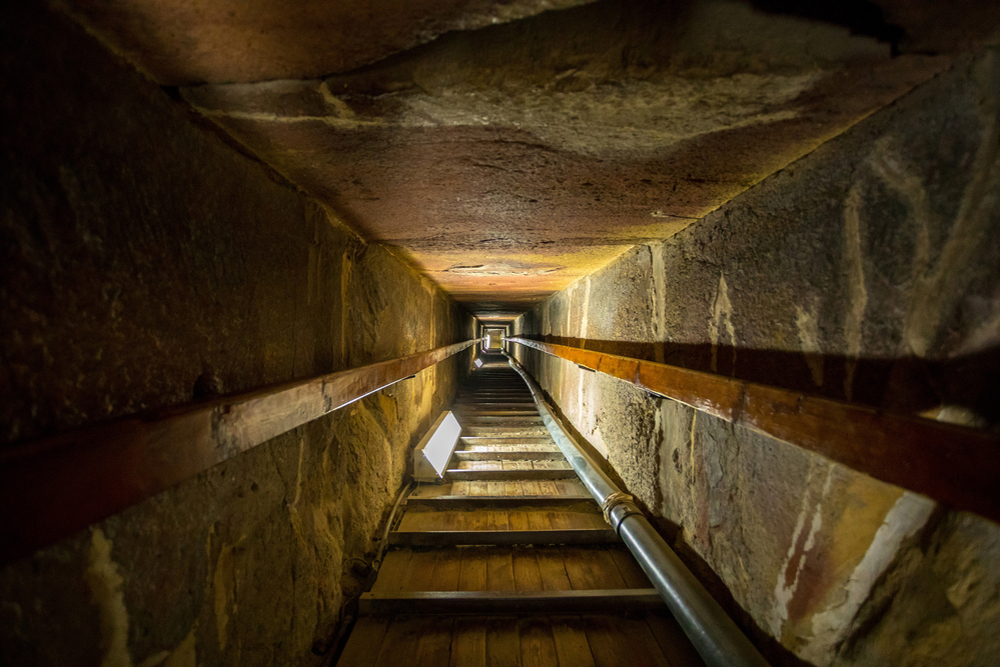Archeologists Discover Another Secret Corridor Inside the Great Pyramid of Giza

It is the only remaining member of the Seven Wonders of the Ancient World still standing, but that doesn’t mean the Great Pyramid of Giza still can’t surprise us. As archeologists acquire better tools for penetrating the ancient walls, more chambers and corridors appear that may one day be physically explored with drones or robots. The ScanPyramids project is privy to those latest technologies and announced this week details about a recently discovered corridor inside the North face of the pyramid in the mysterious “Chevron zone.”

“This discovery, in my opinion, is the most important discovery of the 21st Century.”
That proclamation was made to reporters by Zahi Hawass, Egypt’s former minister of antiquities and a leading archeologist, in announcing new revelations, published in the journal Nature Communications, about a corridor-shaped structure first detected in 2016 and 2017 by a ScanPyramids team. ScanPyramids’ mission since its founding in 2015 is to scan Old Kingdom Egyptian Pyramids – The Great Pyramid (Khufu), Khafre (the middle of the three Ancient Egyptian Pyramids of Giza), the early Bent pyramid and the unusual Red pyramid – in hopes of detecting internal spaces and tunnels without any drilling or other forms of destruction. Techniques include Infrared thermography, 3D simulation and cosmic-ray muon radiography imaging. The last tool was the first to find the latest corridor, which the archeologists then confirmed with images taken through a 6mm-thick endoscope feed through a tiny joint in the pyramid’s stones. Since then, the ScanPyramids team went on to take new measurements benefiting from the extreme sensitivity of nuclear emulsion films from Nagoya University and gaseous detectors from CEA Instruments.
“In this paper, we report on the first precise analysis of the void found with cosmic-ray muon radiography behind the North Face Chevron and named the ScanPyramids North Face Corridor (NFC). Its shape and location are accurately evaluated by focusing on the 7 following parameters: its 3 dimensions (width W, height H, length L), its position (North-South position X, East-West position Y, altitude Z) and its slope α. While a potential, future exploration will primarily require a precise determination of Y and Z, most of these parameters are also important to understand the role of the Chevron.”
The “Chevron” refers to the huge inverted V-shaped gabled limestone beams which cover the original entrance to the descending corridor (DC) on the North side of Khufu’s Pyramid. The North side has a number of chevrons, some hidden, which have long baffled researchers. The ‘gable’ is the flat triangular end piece under a conventional pitched roof that is made of wood or stone. Its purpose is to support the sloped roof and protect the interior from the elements. These enormous limestone chevron blocks make no sense on the Great Pyramid because there is no need to relieve the weight above them to protect something below them.
“Khufu’s Pyramid is the first pyramid, in the history, that uses a Chevron technique to cover internal structures and prevent them from collapsing. We can find Chevron on the North Face, in the queen’s chamber ceiling and above the king’s chamber. The construction process of the oldest of the seven wonders of the ancient world is one of the most important archaeological mysteries. Any discovery of previously unknown internal structures could contribute to the knowledge on the construction of this Pyramid.”
The newly discovered corridor may be the space that is doing the protecting, not the chevron, according to the study. It is approximately 9 meters (29 feet) in length, and has a transverse section of about 2 by 2 meters (6.5 by 6.5 feet). There are many large internal structures or rooms inside the Great Pyramid which are connected by narrow corridors laid out in a north-south direction at a distance of about 7 meters (23 feet) east from the center of the pyramid. You may be familiar with some of them – the queen’s chamber, the grand gallery and the king’s chamber. That last chamber contains a broken sarcophagus thought to have once contained the mummy of King Khufu – it is a room said to have been visited by Napoleon, who may have had the proper small stature to fit into the tiny spaces. (Photos and illustrations can be seen in the study.)
“This corridor, it’s protecting or reducing the pressure on something beneath it, Might be chamber, might be something else. Very soon, we can figure out what is the main issue of this corridor.”
Mostafa Waziri of Egypt’s Supreme Council of Antiquities says he thinks the unfinished corridor may have been placed there to relieve the pressure of the weight of the stones around the main entrance seven meters (23 feet) away from it, or it may be reducing the pressure over another as yet undiscovered corridor or chamber. This has already been observed in other areas inside the Great Pyramid – there five rooms above the king’s burial chamber which are believed to be redistributing the weight of the massive pyramid to protect the chamber. While many researchers believe the king’s mummy has been looted from this burial chamber, there is hope that the pharaoh had more than one burial chamber.
“To our knowledge, this study is the first characterization of the position and dimensions of a void detected by cosmic-ray muons with a sensitivity of a few centimeters only. On the archaeological side, the discovery of a void located behind the Chevron and having a larger cross-section than the corridors connecting the inner structures of the pyramid may be decisive in approaching the role of this Chevron. Last but not least, the NFC does not seem to connect to the SP-BV, though a smaller corridor of <1.0 m between these two structures cannot be completely ruled out from these measurements.”

This discovery has both past and future implications for ScanPyramids research. While the team could not come to a conclusive agreement on the purpose of North Face Chevron, it went a long way in showing that the many corridors connecting the inner structures are more than just passageways – they are providing the service of relieving the pressure of the massive weight of the pyramid – an unbelievable achievement in construction that rivals the actual act of building the Great Pyramid itself. This will help archeologists studying Khufu’s pyramid and the others determine where similar pressure-reliving corridors might be located. It will also speed up the process of investigating these pyramids and hopefully locate hidden entrances and corridors which will facilitate better inspections using drones, robots and careful human archeologists.
Is this “the most important discovery of the 21st Century” involving the Great Pyramid of Giza? That remains to be seen. It is definitely impressive and it highlights the achievements of these ancient Egyptians who designed and built these great wonders oof the world without Infrared thermography, 3D simulation and cosmic-ray muon radiography imaging.




